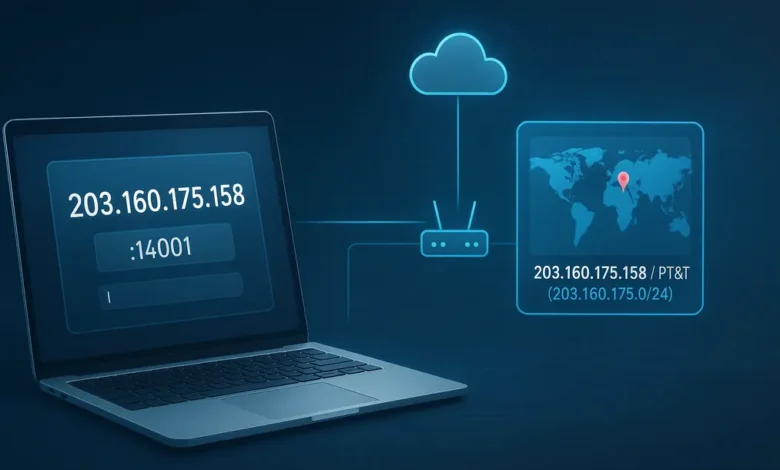Understanding 203.160.175.158.14001: A Complete Guide to Its Meaning, Use, and Relevance

When you come across something like 203.160.175.158.14001, your first thought may be that it looks overly technical or even confusing. It has the structure of an internet address, but it also contains a number that does not immediately fit into the common formats people are used to. In reality, this combination is not as complicated as it looks. It can be understood by breaking it down into two parts—an IP address and a port number.
In the world of digital communication, IP addresses and ports are fundamental. Every service you access on the internet, from checking your email to streaming a movie, runs on these underlying structures. That means a number like 203.160.175.158.14001 is not just random—it represents a way of connecting to a service on a server somewhere in the world.
What Exactly Is 203.160.175.158.14001?
At its core, 203.160.175.158.14001 is best interpreted as an IP address paired with a port number. The first part, 203.160.175.158, looks like a standard IPv4 address. IPv4 addresses are made up of four groups of numbers, each ranging from 0 to 255, separated by dots. This is the most common system for identifying devices on a network.
The second part, 14001, is slightly different. This number functions as a port, which is essentially a virtual channel used by computers to separate different types of services. Think of it as a specific doorway into a building. The building is the IP address, and the port is the door you choose to enter. Without the port, your request might not know which service inside the building it should be directed to.
Normally, IP and port combinations are written with a colon, such as 203.160.175.158:14001. However, the format you see here uses a dot. Even if the punctuation is slightly unusual, the logic behind it remains the same—it points to a device on the internet that is running a particular service on port 14001.
Why Do IP Addresses Use Port Numbers?
Understanding why a string like 203.160.175.158.14001 exists requires you to know why port numbers are so important. They serve several key purposes in computer networking:
Directing Network Traffic to the Right Service
A single server can host multiple services. For example, it may run a website, an email server, a file transfer system, and a database all at the same time. If a request arrives without specifying a port, the server would not know which service you are trying to reach. The port number acts as a guide that directs the traffic to the correct service.
Supporting Specialized Applications
Not all services operate on the default ports like 80 or 443. Many custom applications are designed to run on less common ports to avoid conflicts and to allow administrators greater flexibility. Port 14001 is not one of the standard ones, which means it could be used for a custom-built application, a testing environment, or a business tool designed for internal use.
Enhancing Security and Control
Although using an uncommon port is not a true security feature on its own, some administrators choose to run sensitive services on higher-numbered ports like 14001. This is done to make it less obvious to outsiders, while still being easily accessible to those who know the exact address.
Possible Uses of 203.160.175.158.14001
A string like 203.160.175.158.14001 is often encountered in contexts where a server provides a specialized service. Here are a few likely scenarios:
Internal Business Applications
Companies sometimes operate internal applications on raw IP addresses with specific port numbers. Instead of using a branded domain name, they simply provide employees with an address like 203.160.175.158.14001 to access a database, a management tool, or a reporting system. This is especially common during development phases or for systems not intended for public access.
Game or Media Servers
In gaming and multimedia environments, servers often use ports to separate different sessions or functionalities. For example, multiplayer games frequently require players to connect to a server using an IP and port combination. Similarly, a media server could be running on port 14001 to deliver video or audio streams to authorized users.
Administrative or Login Panels
It is common for network administrators to set up control panels, dashboards, or monitoring tools on non-standard ports. Instead of placing these sensitive tools on common ports that attract constant scanning, they are placed on higher numbers like 14001. This allows for easier internal access while keeping them less obvious to casual outsiders.
Security Implications of IPs Like 203.160.175.158.14001
While these types of addresses are useful, they also come with risks if not properly managed. Security is a major concern any time you expose a service on the internet.
Exposure to Scanning and Attacks
Hackers regularly scan blocks of IP addresses for open ports. If port 14001 is active and unprotected, it could become a target. Attackers often try to identify what service is running and whether there are vulnerabilities they can exploit.
The Problem with Relying on Obscurity
Running a service on port 14001 instead of a well-known port might reduce casual attempts, but it does not offer true protection. Once a scanner identifies that the port is open, the service is just as exposed as it would be on any other port. Real protection requires firewalls, authentication, and encryption.
Safe Handling for Users
If you come across 203.160.175.158.14001, you should avoid trying to connect to it unless you know exactly what it is and who operates it. Accessing unknown servers can expose you to risks, especially if they are designed to trick users into connecting. It is always safer to confirm with the administrator or source before attempting to interact with such an address.
Best Practices When Dealing with IP and Port Combinations
For professionals who work with IP addresses and ports regularly, there are some best practices to keep in mind.
Use Secure Connections
Always ensure that services running on custom ports, such as port 14001, are properly secured with encryption and authentication. This prevents unauthorized users from gaining access, even if they discover the port.
Keep Documentation Clear
When addresses like 203.160.175.158.14001 are used within an organization, it is essential to maintain proper documentation. Employees and team members need to know what the service is for, when it should be accessed, and who is responsible for managing it.
Limit Public Exposure
Not all services need to be available on the open internet. Restrict access whenever possible by using firewalls, VPNs, or private networks. This reduces the chance of unauthorized traffic reaching the service in the first place.
Why Understanding 203.160.175.158.14001 Matters
It may seem like a small detail in the grand scheme of the internet, but learning to interpret something like 203.160.175.158.14001 gives you deeper insight into how the digital world functions. Every time you visit a website, join an online meeting, or use cloud storage, you are indirectly using IP addresses and ports. Knowing that 203.160.175.158.14001 is an example of this structure helps demystify the technical foundations of everyday online activity.
Instead of seeing a random string of numbers, you now understand that this is a doorway to a specific service, running on a particular server. With that perspective, you begin to appreciate how carefully orchestrated the internet is—millions of services running side by side, each identified by its own IP and port combination.
Conclusion
The number 203.160.175.158.14001 may look confusing at first glance, but it represents something very practical: a server’s IP address paired with a port number. The IP identifies the device, while the port directs you to a specific service running on it. Whether used for internal business applications, game servers, or administrative tools, this structure is fundamental to how digital communication works.
However, it also carries security implications. Services exposed on the internet must be carefully managed to prevent misuse. By understanding the role of addresses like 203.160.175.158.14001, you gain a clearer view of the hidden framework that powers everything we do online.



